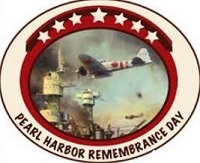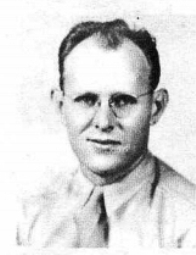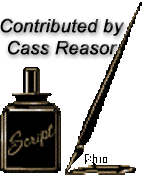|
Charles Edison Baum  
The wars on opposite sides of the
world fought by Charles Baum of Whitesboro and Leonard Riley of Denison were
very different, but both were extraordinary examples of courage, steadfastness,
and faith. Theirs are two of those sixteen million stories, and they bear
remembering. More than sixty years ago, Charlie
Baum found his world turned upside down because of events in a place most
Americans had never heard of, a rocky peninsula on the island of Luzon in the
Philippines, which separates the South China Sea from Manila Bay. It is called
Bataan. Charles Edison Baum was born on July
19, 1917, in Whitesboro to George Campbell Baum Sr. and Callie White Baum. He
is a great grandson of Captain Ambrose B. White, who founded Whitesboro in
1848. He was the youngest of three boys. G. C., Jr., and Al Baum were his older
brothers. He also had a half-sister, Nettie Baum Ashley. Baum grew up on Water
Street, and his story sounds like something from Booth Tarkington or an Andy
Hardy movie. He was a quick kid, a bright kid who made good grades. He made
friends easily, he played football, and Sunday mornings would find him at the
Methodist Church. Baum
graduated from high school in 1937 from the same building he had entered as a
first grader. A short time later, he took a job with E. T. Allen, Sr., in the
grocery and grain business. “I did a little bit of everything at Mr. Allen’s
store. I was a delivery boy, I stocked the grocery shelves, and I moved the sacks
of grain. And he was like a daddy to me,” Baum said. “After my daddy died, he
sort of looked after me. His son, E. T., Jr.— we all called him ‘Mike’—was like
a brother. We were best friends.” He joined the Army Air Corps. “I went
to Sherman to volunteer,” he said. “Then I rode the Interurban to Dallas. I was
sworn in that same day.” The army liked men like Baum. He was twenty-four years
old, stood nearly six feet tall, and weighed a healthy 215 pounds.
When he got
back to Whitesboro, he told first Mr. Allen of his decision and, later, his
mother. Recalling the reaction of his employer and close friend, Baum said, “He
took me to the back of the store where we each sat down on a sack of grain, and
he talked to me just like a daddy.” The recollection of this conversation held
sixty-seven years ago brought tears to his eyes. When he told his
mother, Callie Baum made a simple request of her youngest son. “Mother asked me
to read my Bible daily, if I could. I did my best to honor that request all the
time I was gone,” he said. Baum received his brief basic training
at March Field, California, and by September he was at Clark Field on Luzon in
the Philippines. He was assigned to the 7th Material Squadron attached to the
19th Bombardment Group.
For the Americans in Hawaii, the war began at 8:30 in the
morning on December 7, 1941. Nine hours later, nine hours during which little
or nothing was done to prepare Clark Field for what was sure to come, the
Japanese struck there. Baum operated a .50-caliber machine gun in the defense
of Clark Field and the Bataan Peninsula. On April 8, 1942, Pfc. Baum (actually
he was a sergeant though his promotion had not been made official due to poor
communications) and his unit were in front of the first line of contact. He and
a second lieutenant dropped back to prepare machine gun pits in case of
retreat. “We used the machine gun to hold back the enemy as we retreated,” he
recalled. “We fired 18,000 rounds in about four hours time. The gun barrel bent
from being overheated.” Immediately, the squad
dismantled the gun and retreated with the Japanese in pursuit. The Americans
scrambled to the position where the front line was supposed to be established.
No one was there. The enemy attempted to surround them, and they fought back.
“I had my .45 on my side,” Baum said. “We were chased almost to Camp
Cabanatuan. We tried to form a line, but orders came down that night to
surrender.” Ordered to stack their weapons in preparation for the surrender,
the squad tossed them into the sea instead. “We stacked them in Manila Bay,” Baum said with a little
chuckle. At dawn on April 9, with 10,000
Americans still stubbornly defending the island of Corregidor off the tip of
Bataan, Maj. Gen. Edward P. King surrendered his used-up army of 75,000 (11,796
Americans, 66,000 Filipinos and 1,000 Chinese Filipinos) to the Japanese. When
he asked a Japanese colonel if the prisoners would be treated properly, the
officer replied, “We are not barbarians.” Half a world away back home in
Whitesboro, Callie Baum and other family members received word that Charles E.
Baum was missing in action. It would be eighteen months before they would learn
that he was a prisoner of war. Prisoner
of War The victors were unprepared to deal
with the vanquished. The Japanese had expected the Americans to continue
fighting for several more months and had anticipated no more than 25,000
prisoners. Gen. Homma, overall commander of Imperial forces in the Philippines,
already had decided to move the POWs to Camp O’Donnell, an American air corps
base about one hundred miles north of Marivales, the principal city in southern
Bataan. Knowing that many of his soldiers were sick, wounded and weak from
months on short rations, Gen. King offered to use American trucks to transport
the prisoners. Gen. Homma refused. They would march.Baum was one of the first
group of seventy-five men to make the continuous four-day-and-night march. His
“uniform” was a pair of shorts, and he carried a New Testament hidden inside
the waistband. The Bible was a gift from USA Chaplain Ernest A. Israel, signed
and dated June 30, 1941. The inscription reads: “Good luck, Charles.” Baum
carried the New Testament throughout his captivity. A diary entry written on a
blank page reads: “Dec.14 – Sunday – I pray they will keep this day holy.” The Japanese showed
little concern for their captives on the march. The prisoners got neither food
nor water. They were not allowed to stop and rest. They were prodded with
bayonets and were under constant threat of being shot to death on the spot. Of the 75,000 who left Marivales,
54,000 arrived at Camp O’Donnell. Some Americans and many Filipinos had found
opportunities to escape and taken them. It is estimated that 5,000 to 10,000
Filipinos had died or been murdered along the way, along with 600 to 650
Americans. Death on the march was an iffy thing. Some of the Japanese soldiers
guarding the prisoners treated them, if not well, then at least humanely, while
a half a mile up the road, prisoners were murdered without apparent cause. In
the Camps Baum
was kept at Camp O'Donnell for sixteen days, and then he was sent out
on a salvaging detail for the Japanese. After a month and a half
of this detail he became ill with
malaria. No medical attention was given to the prisoners. “We looked
after each
other the best we could,” he said. “Even if you were sick, you still
had to
work. If your fever got up to 105 degrees, you could ‘stay in’ for the
day.
Otherwise you had different camp jobs to do.”The malaria brought chills
with
the fever. Baum remembers wrapping himself in three blankets and still
being
unable to stop the shaking. Later while in a different camp location,
he
developed beriberi, a disease of the nerve endings which brings about
muscular
paralysis, weakness, and extreme weight loss. This is caused by the
lack of
vitamin B in the diet.
“We had very little food provided by our captors,” Baum
explained. “A small serving of rice every day, and sometimes it was every two
days. We had to forage for anything else to eat. A starving man is not too
particular about what he eats. We ate dead fish, worms, grass, grasshoppers,
chemical salt, soup made from the stalks of pepper after the Japanese had
removed the peppers, or soup made from the bones of animals.” Once they
butchered and cooked a mangy camp dog that had strayed onto the premises. Baum
chewed animal bones in order to provide calcium to his undernourished body. He
cleaned his teeth with charcoal. After contracting malaria Baum was
sent back to Camp Cabanatuan in Central Luzon. There he served as first
sergeant of Company F. His job was to supervise the burial of allied prisoners
who were dying at the rate of twenty-five to seventy-five each day. The
mounting malnutrition, diarrhea and malaria took a heavy toll. Very few medical
supplies were available at Luzon, and these items were largely smuggled in by
the Filipinos. “These men would have been executed immediately if they had been
caught,” Baum said. The prisoners were subjected to frequent beatings and barrages of verbal insults and accusations. There were
inconsistencies in the guards’ behavior and treatment of their charges. “We
never knew what to expect,” said Baum. “They required us to learn the Japanese
language. We had to learn in five minutes to count off perfectly. The men who
failed at this task were beaten until they could perform satisfactorily.”Even
so, there were snatches of human kindness and compassion. Once when Baum was
quite ill with malaria, one of the guards brought him some bananas. “His name
was Tanaka, and I had been teaching him some English. I think he appreciated
that and the fruit was his way of thanking me. He saved my life.”
In the spring of 1944, Baum and other
Americans were moved by ship to Japan. “The transport ships that carried us
were old antiques,” he said. “They herded us in like cattle. We were prodded on
board with bayonets.”During the ninety-day journey, Baum witnessed American
soldiers go crazy with the effects of the malaria and jump overboard into the
ocean. There was very little food and very harsh treatment. The transport ships
were unmarked, and the two vessels immediately following Baum’s ship were sunk. The Bible got passed around among the
other prisoners, too. Often they would ask to borrow it just to read a favorite
passage. Baum kept a dated written account on the blank spaces of its pages. He
also managed to keep his class ring with him and a lucky $2.00 bill that
belonged to a friend back home. Baum was “holding” it for him at the time of
his enlistment.
In the weeks following the Japanese
surrender and his liberation, he was carried by hospital ship to Tokyo Bay,
flown to a Manila replacement center, and transported by ship to San Francisco.
He was provided with doctors and medical care and placed on a nutrition regimen
that slowly increased his food intake and allowed him to begin to gain weight. The End of the Long March Home Charlie Baum came marching home on Friday morning, October 26, 1945 when he came back to Whitesboro. His family, friends and neighbors, Whitesboro schoolchildren who had been dismissed from classes for the day, and the entire town were with Callie Baum at the train depot to welcome her boy home. “Mother never lost faith that I would come back,” Baum said. “All that time and she never wavered. She told everyone she met that God would bring me home again." Shortly
after his homecoming, Baum met Waunema Ruth Chisum. "I didn't
know her before.” he said. "I saw this really pretty girl wearing
a lacey dress walking down the street one day. I said, 'Man
alive! Tho's that gal?' And Mr. Allen introduced us. "A
courtship began, and the couple married June 24, 1946. Daughter
Kay was born in 1949, and a second daughter, Susan, arrived in 1954.
Baum opened an ice cream parlor and confectionery business
downtown, which he ran for a couple of years. In 1948, he
enrolled in Austin College, where he attended classes for the next two
years. Friend Norman Bennett lived in Gainesville; he would stop
by on his way to class to pick up Baum, and they would carpool to
Sherman. In the early 1950s, Baum served as
Whitesboro’s postmaster. When the political party in power changed, he was
replaced. He took a job working in the hardware business with a local store and
was looking into the possibility of purchasing the business. Instead, his life
course took another turn and headed him down a different path.In 1953,
Superintendent Lyman Robinson offered Baum a job teaching at the junior high
school. He accepted the position teaching science, math, health and P. E. He
also coached football and girls’ basketball. His teams excelled under his
tutelage. “I ran those girls forty-five minutes straight nearly every day—up
and down those bleachers. I had them where they could move on that court.” He
went back to Austin College and completed the twenty-one In 2004, the Whitesboro Intermediate
School Gym was dedicated and named in his honor. On that occasion the tribute
read in part, “Charles E. Baum for his lifelong service to country, community,
and family.”Life is good,” Baum said with a smile. “I do not harbor any
animosity for the things that happened to me. Would I do it all again? Yes, I
sure would. We’re the luckiest people on earth. You’ve got to go through
something to appreciate it.”
 Military Veterans Susan Hawkins © 2024 |